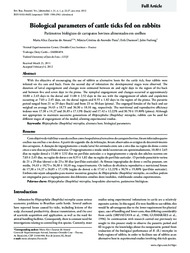Biological parameters of cattle ticks fed on rabbits.
Biological parameters of cattle ticks fed on rabbits.
Author(s): AMARAL, M. A. Z. do; PRATA, M. C. de A.; DAEMON, E.; FURLONG, J.
Summary: With the objective of encouraging the use of rabbits as alternative hosts for the cattle tick, four rabbits were infested on the ears and back. From the second day of infestation the developmental stages were observed. e duration of larval engorgement and changes were estimated between six and eight days in the region of the back and between 've and seven days in the pinna. e nymphal engorgement and changes occurred at approximately 10.80 ± 2.65 days in the dorsal and 11.00 ± 2.52 days in the ear, with the engorgement of adults and copulation occurring at 7.03 ± 2.45 days, on the dorsal region and 8.55 ± 1.82 days in the region of the pinna. e parasitic period ranged from 21 to 29 days (back) and from 23 to 30 days (pinna). e engorged females of the back and ear weighed on average 34.43 ± 18.73 and 36.30 ± 18.10 mg, respectively. e nutritional and reproductive e/ciency indexes were 17.38 ± 14.27 and 26.85 ± 17.13% (back) and 17.42 ± 12.22% and 30.70 ± 19.80% (pinna). Although not appropriate to maintain successive generations of Rhipicephalus (Boophilus) microplus, rabbits can be used for di:erent stages of engorgement of the ixodid, allowing experimental studies.
Publication year: 2012
Types of publication: Journal article
Unit: Embrapa Dairy Cattle
Observation
Some of Embrapa's publications are published as ePub files. To read them, use or download one of the following free software options to your computer or mobile device. Android: Google Play Books; IOS: iBooks; Windows and Linux: Calibre.
Access other publications
Access the Agricultural Research Database (BDPA) to consult Embrapa's full library collection and records.
Visit Embrapa Bookstore to purchase books and other publications sold by Embrapa.

